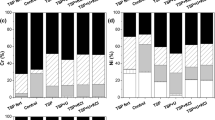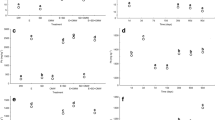Abstract
The aim of the study was to determine whether the application of superphosphate fertiliser to soils contaminated with mine wastes can inhibit metal and metalloid mobility (Cu, Pb, Zn, Cd, Fe, Mn, As, Sb) in the long term. Contaminated soils contained sulfide- and sulfate-rich waste materials from the Broken Hill and Mt Isa mining centres. Results of long-term (10 months) column experiments demonstrate that fertiliser amendment had highly variable effects on the degree of metal and metalloid mobilisation and capture. Rapid release of metals from a sulfate-rich soil showed that phosphate amendment was ineffective in stabilising highly soluble metal-bearing phases. In a sulfide-rich soil with abundant organic matter, complexing of metals with soluble organic acids led to pronounced metal (mainly Cd, Cu and Zn) release from fertiliser-amended soils. The abundance of pyrite, as well as the addition of fertiliser, caused persistent acid production over time, which prevented the formation of insoluble metal phosphate phases and instead fostered an increased mobility of both metals and metalloids (As, Cd, Cu, Sb, Zn). By contrast, fertiliser application to a sulfide-rich soil with low organic carbon content and a sufficient acid buffering capacity to maintain near-neutral pH resulted in the immobilisation of Pb in the form of newly precipitated Pb phosphate phases. Thus, phosphate stabilisation was ineffective in suppressing metal and metalloid mobility from soils that were rich in organic matter, contained abundant pyrite and had a low acid buffering capacity. Phosphate stabilisation appears to be more effective for the in situ treatment of sulfide-rich soils that are distinctly enriched in Pb and contain insignificant concentrations of organic matter and other metals and metalloids.









Similar content being viewed by others
References
Alam, M. G. M., Tokunaga, S., & Maekawa, T. (2001). Extraction of arsenic in a synthetic arsenic-contaminated soil using phosphate. Chemosphere, 43, 1035–1041.
Bosso, S. T., Enzweiler, J., & Angelica, R. S. (2008). Lead bioaccessibility in soil and mine wastes after immobilization with phosphate. Water, Air, and Soil Pollution, 195, 257–273.
Cao, X., Ma, L. Q., Chen, M., Singh, S. P., & Harris, W. G. (2002). Impacts of phosphate amendments on lead biogeochemistry at a contaminated site. Environmental Science and Technology, 36, 5296–5304.
Cao, R. X., Ma, L. Q., Chen, M., Singh, S. P., & Harris, W. G. (2003). Phosphate-induced metal immobilization in a contaminated site. Environmental Pollution, 122, 19–28.
Cao, X., Ma, L. Q., Singh, S. P., & Zhou, Q. (2008). Phosphate-induced lead immobilization from different lead minerals in soils under varying pH conditions. Environmental Pollution, 152, 184–192.
Chen, M., Ma, L. Q., Singh, S. P., Cao, R. X., & Melamed, R. (2003). Field demonstration of in situ immobilization of soil Pb using P amendments. Advances in Environmental Research, 8, 93–102.
Chrysochoou, M., Dermatas, D., & Grubb, D. G. (2007). Phosphate application to firing range soils for Pb immobilization: the unclear role of phosphate. Journal of Hazardous Materials, 144, 1–14.
Cotter-Howells, J., & Caporn, S. (1996). Remediation of contaminated land by formation of heavy metal phosphates. Applied Geochemistry, 11, 335–342.
Evangelou, V. P., & Zhang, Y. L. (1995). A review: pyrite oxidation mechanisms and acid mine drainage prevention. Critical Reviews in Environmental Science and Technology, 25, 141–199.
Forrestal, P. J. (1990). Mount Isa and Hilton silver–lead–zinc deposits. In F. E. Hughes (Ed.), Geology of the mineral deposits of Australia and Papua New Guinea (pp. 927–934). Melbourne: The Australasian Institute of Mining and Metallurgy.
Gulson, B. L., Mizon, A. J., Law, A. J., Korsch, M. J., & Adams, J. J. (1994). Source and pathways of lead in humans from the Broken Hill mining community: an alternative use of exploration methods. Economic Geology, 89, 889–908.
Harris, D. L., & Lottermoser, B. G. (2006a). Evaluation of phosphate fertilisers for ameliorating acid mine waste. Applied Geochemistry, 21, 1216–1225.
Harris, D. L., & Lottermoser, B. G. (2006b). Phosphate stabilization of polyminerallic mine wastes. Mineralogical Magazine, 70, 1–13.
Hettiarachchi, G. M., Pierzynski, G. M., & Ransom, M. D. (2001). In situ stabilization of soil lead using phosphorus. Journal of Environmental Quality, 30, 1214–1221.
Kilgour, D. W., Moseley, R. B., Barnett, M. O., Savage, K. S., & Jardine, P. M. (2008). Potential negative consequences of adding phosphorus-based fertilisers to immobilize lead in soil. Journal of Environmental Quality, 35, 1733–1740.
Laperche, V., Traina, S. J., Gaddam, P., & Logan, T. J. (1996). Chemical and mineralogical characterizations of Pb in a contaminated soil: reactions with synthetic apatite. Environmental Science and Technology, 30, 3321–3326.
Laperche, V., Logan, T. J., Gaddam, P., & Traina, S. J. (1997). Effect of apatite amendments on plant uptake of lead from contaminated soil. Environmental Science and Technology, 31, 2745–2753.
Lawlor, A. J., & Tipping, E. (2003). Metals in bulk deposition and surface waters at two upland locations in northern England. Environmental Pollution, 121, 153–167.
Lin, C. W., Lian, J., & Fang, H. H. (2005). Soil lead immobilization using phosphate rock. Water, Air, and Soil Pollution, 161, 113–123.
Lombi, E., Sletten, R. S., & Wenzel, W. W. (2000). Sequentially extracted arsenic from different size fractions of contaminated soil. Water, Air, and Soil Pollution, 124, 319–332.
Ma, L. Q., & Rao, G. N. (1999). Aqueous Pb reduction in Pb-contaminated soils by Florida phosphate rocks. Water, Air, and Soil Pollution, 110, 1–16.
Ma, Q. Y., Logan, T. J., & Traina, S. J. (1995). Lead immobilization from aqueous solutions and contaminated soils using phosphate rocks. Environmental Science & Technology, 29, 1118–1126.
Martinez, C. E., McBride, M. B., Kandianis, M. T., Duxbury, J. M., Yoon, S.-J., & Bleam, W. F. (2002). Zinc–sulfur and cadmium–sulfur association in metalliferous peats: evidence from spectroscopy, distribution coefficients, and phytoavailability. Environmental Science and Technology, 36, 3683–3689.
Martinez, C. E., Jacobson, A. R., & McBride, M. B. (2004). Lead phosphate minerals: solubility and dissolution by model and natural ligands. Environmental Science and Technology, 38, 5584–5590.
Melamed, R., Cao, X., Chen, M., & Ma, L. Q. (2003). Field assessment of lead immobilization in a contaminated soil after phosphate application. Science of the Total Environment, 303, 117–127.
Miretzky, P., & Fernandez-Cirelli, A. (2008). Phosphates for Pb immobilization in soils: a review. Environmental Chemistry Letters, 6, 121–133.
Morin, K. A., & Hutt, N. M. (1997). Environmental geochemistry of mine site drainage. Vancouver: MDAC.
Munksgaard, N. C., & Lottermoser, B. G. (2010). Effects of wood bark and fertilizer amendment on trace element mobility in mine soils, Broken Hill, Australia: implications for mined land reclamation. Journal of Environmental Quality, 39, 2054–2062.
Munksgaard, N. C., & Lottermoser, B. G. (2011). Phosphate amendment of mining-contaminated soils, Broken Hill, Australia: fixation or release of contaminants? Water, Air, and Soil Pollution, 215, 373–397.
NEPC (National Environment Protection Council) (1999). Assessment of site contamination. Schedule B (1) guideline on the investigation levels for soil and groundwater. http://www.ephc.gov.au/sites/default/files/ASC_NEPMsch__01_Investigation_Levels_199912.pdf. Accessed 16/5/2011.
NIH (National Institute of Mental Health, Bethesda) (2010). ImageJ public domain Java image processing program by Wayne Rasband, Research Services Branch. http://rsbweb.nih.gov/ij/index.html. Accessed 16/5/2011.
NWQMS (National Water Quality Management Strategy). (2000). Australian and New Zealand guidelines for fresh and marine water quality. Canberra, Australia: Environment and Conservation Council, Agriculture and Resource Management Council of Australia and New Zealand.
Park, J. H., Bolan, N., Megharaj, H., & Naidu, R. (2011). Comparative value of phosphate sources on the immobilization of lead, and leaching of lead and phosphorus in lead contaminated soils. Science of the Total Environment, 409, 853–860.
Perkins, W. G. (1990). Mount Isa copper ore bodies. In F. E. Hughes (Ed.), Geology of the mineral deposits of Australia and Papua New Guinea (pp. 935–941). Melbourne: The Australasian Institute of Mining and Metallurgy.
Plimer, I. R. (1984). The mineralogical history of the Broken Hill lode, NSW. Australian Journal of Earth Science, 31, 379–402.
Ryan, J. A., Zhang, P., Hesterberg, D., Chou, J., & Sayers, D. E. (2001). Formation of chloropyromorphite in a lead-contaminated soil amended with hydroxyapatite. Environmental Science and Technology, 35, 3798–3803.
Scheckel, K. G., & Ryan, J. A. (2004). Spectroscopic speciation and quantification of lead in phosphate-amended soils. Journal of Environmental Quality, 33, 1288–1295.
Smart, R., Skinner, B., Levay, G., Gerson, A., Thomas, J., & Sobieraj, H. (2002). ARD test handbook. Melbourne: AMIRA International.
Smith, K. S., & Huyck, H. L. O. (1999). An overview of the abundance, relative mobility, bioavailability, and human toxicity of metals. In G. S. Plumlee & M. J. Logsdon (Eds.), The environmental geochemistry of mineral deposits, part A: processes, techniques, and health issues. Reviews in economic geology (Vol. 6A, pp. 29–70). Littleton: Society of Economic Geologists.
Spuller, C., Weigand, H., & Marb, C. (2007). Trace metal stabilisation in a shooting range soil: mobility and phytotoxicity. Journal of Hazardous Materials, 141, 378–387.
Taylor, M. P., Mackay, A. K., Hudson-Edwards, K. A., & Holz, E. (2010). Soil Cd, Cu, Pb and Zn contaminants around Mount Isa city, Queensland, Australia: potential sources and risks to human health. Applied Geochemistry, 25, 841–855.
Tipping, E. (1998). Humic ion-binding model VI: an improved description of the interactions of protons and metal ions with humic substances. Aquatic Geochemistry, 4, 3–48.
Wilson, C., Brigmon, R. L., Knox, A., Seaman, J., & Smith, G. (2006). Effects of microbial and phosphate amendments on the bioavailability of lead (Pb) in shooting range soil. Bulletin of Environmental Contamination and Toxicology, 76, 392–399.
Wilson, S. C., Lockwood, P. V., Ashley, P. M., & Tighe, M. (2010). The chemistry and behaviour of antimony in the soil environment with comparison to arsenic: a critical review. Environmental Pollution, 158, 1169–1181.
Yoon, J. K., Cao, X., & Ma, L. Q. (2007). Application methods affect phosphorus-induced lead immobilization from contaminated soil. Journal of Environmental Quality, 36, 373–378.
Zhang, P., & Ryan, J. A. (1998). Formation of pyromorphite in anglesite–hydroxyapatite suspensions under varying pH conditions. Environmental Science and Technology, 32, 3318–3324.
Zhang, P., & Ryan, J. A. (1999a). Formation of chloropyromorphite from galena (PbS) in the presence of hydroxyapatite. Environmental Science and Technology, 33, 618–624.
Zhang, P., & Ryan, J. A. (1999b). Transformation of Pb(II) from cerussite to chloropyromorphite in the presence of hydroxyapatite under varying conditions of pH. Environmental Science and Technology, 33, 625–630.
Zhang, P., Ryan, J. A., & Bryndzia, L. T. (1997). Pyromorphite formation from goethite adsorbed lead. Environmental Science and Technology, 31, 2673–2678.
Zhang, P., Ryan, J. A., & Yang, J. (1998). In vitro soil Pb solubility in the presence of hydroxyapatite. Environmental Science and Technology, 32, 2763–2768.
Acknowledgements
This research was supported under Australian Research Council’s Discovery Projects funding scheme (project number DP0877182). Dr. Yi Hu (JCU AAC) is thanked for analytical support.
Author information
Authors and Affiliations
Corresponding author
Rights and permissions
About this article
Cite this article
Munksgaard, N.C., Lottermoser, B.G. & Blake, K. Prolonged Testing of Metal Mobility in Mining-Impacted Soils Amended with Phosphate Fertilisers. Water Air Soil Pollut 223, 2237–2255 (2012). https://doi.org/10.1007/s11270-011-1019-y
Received:
Accepted:
Published:
Issue Date:
DOI: https://doi.org/10.1007/s11270-011-1019-y




